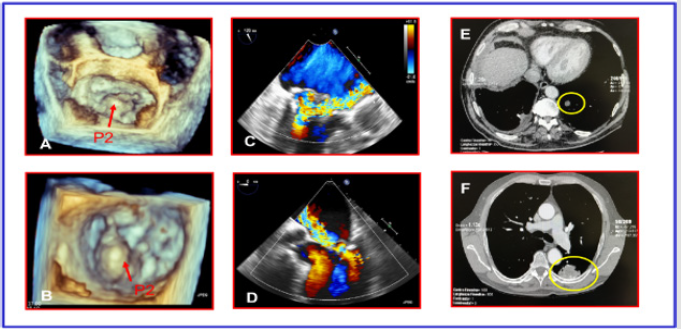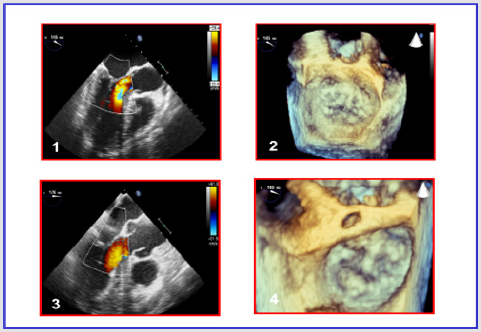“Combined Off-Pump Mitral Valve Repair and Lung Malignancy Resection Through Left Thoracotomy”
Introduction
Transapical, off-pump, minimally invasive Neochord implantation is a technique that has been proven to be safe and effective in treating high-risk patients with degenerative mitral regurgitation (MR) due to leaflet(s) prolapse and/or flail [1-4]. The Neochord procedure characteristics allow to expand indications in selected patients in which standard surgery with cardioplegic arrest of the heart and extracorporeal circulation should be avoided. The procedure is performed using the NeoChord DS1000 system (NeoChord, Inc., Eden Praire, MN) under real-time guidance by transesophageal echocardiography (TEE). This technique can be used in new approaches for combined procedures [4].
Case Reports
A 72-year-old (patient A) and a 60-year-old (patient B) men came to our attention for dyspnea for severe MR due to the presence of severe P2 prolapse (Figures 1A-1D). Both patients had concomitant left inferior lung malignancy. The first, with history of thyroid carcinoma and previous atypical right lung resection for metastasis, presented three new left inferior pulmonary nodules (Figure 1E). The second had an adenocarcinoma in the same position, found during pre-operative CT scan for traditional on-pump surgery (Figure 1F). Both patients were considered at high risk for traditional surgery by the Heart Team. Thus, a Neochord procedure and pulmonary resection combined procedure was planned. Through a left thoracotomy and a postero-lateral left ventriculotomy, firstly four Gore-tex neochords were implanted on the posterior leaflet; secondly an inferior left lobectomy was performed for the youngest man and a resection of three nodules for the oldest one. Total operating time were 120 and145 minute, respectively. At the final intra-operative TEE, no regurgitation was detected (Figure 2). At 24 months no more than trivial to mild regurgitations is present in both patient and the oncological follow-up is negative
Figure 1: 3D transesophageal (TEE) and 2D transthoracic echocardiography (TTE) view of the P2 segment prolapse in patient A (A and C) and patient B (B and D). Pre-operative CT scan: metastatic left lobe lesion (E) and left adenocarcinoma (F).
Figure 2: The final intra-operative 3D transesophageal (TEE) and 2D transthoracic echocardiography (TTE) view: no more mitral regurgitation in patient A (1 and 2) and patient B (3 and 4).
Conclusion
These cases demonstrate the feasibility of combined beating heart surgery to treat structural mitral regurgitation and pulmonary lobectomy or atypical resection to treat malignancy throughout the same access.
For more Articles: https://biomedres01.blogspot.com/




No comments:
Post a Comment
Note: Only a member of this blog may post a comment.